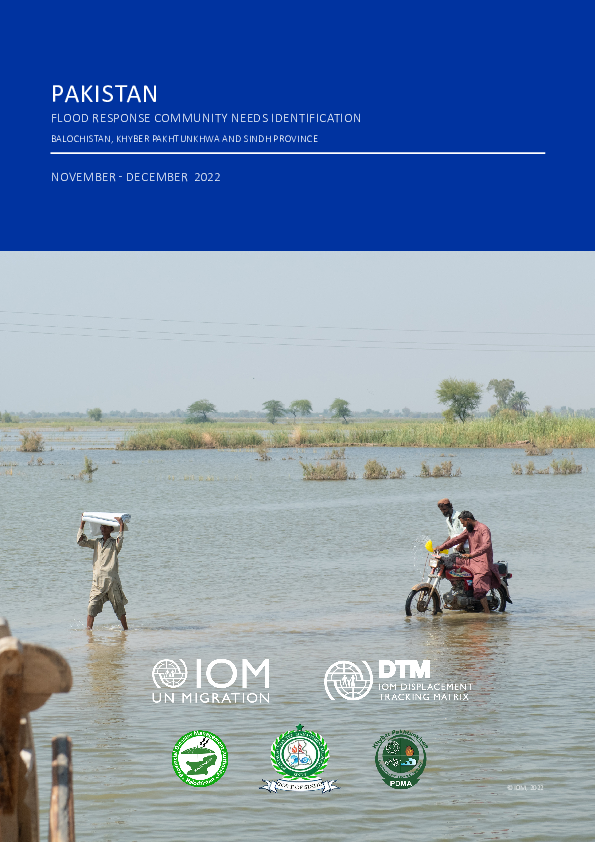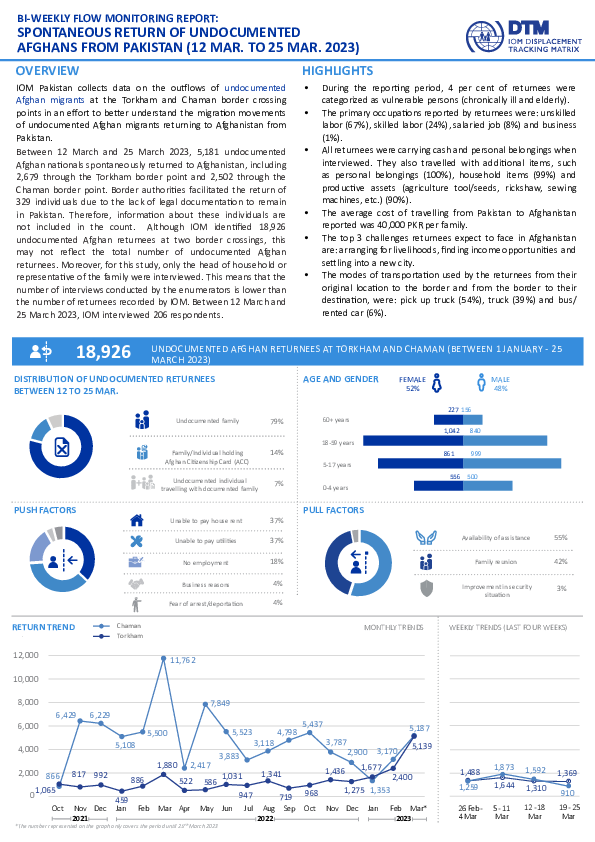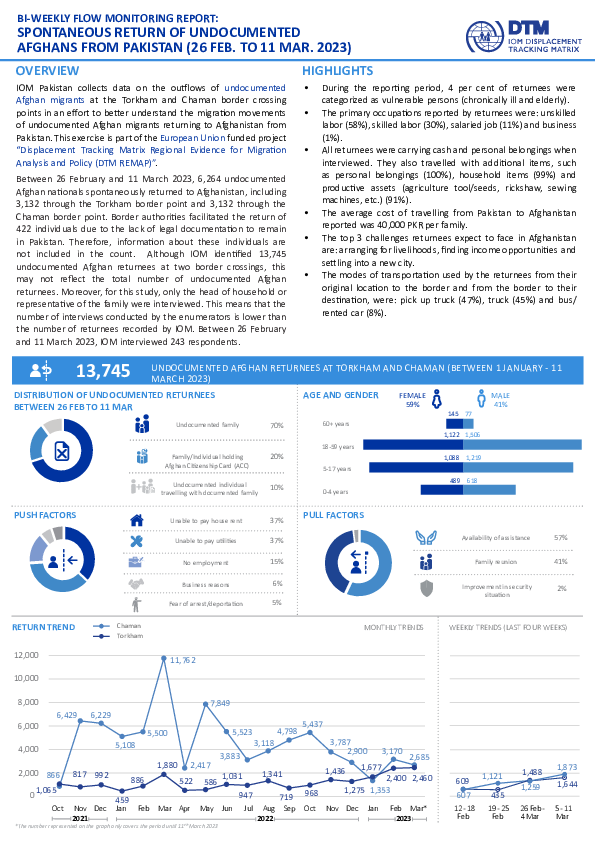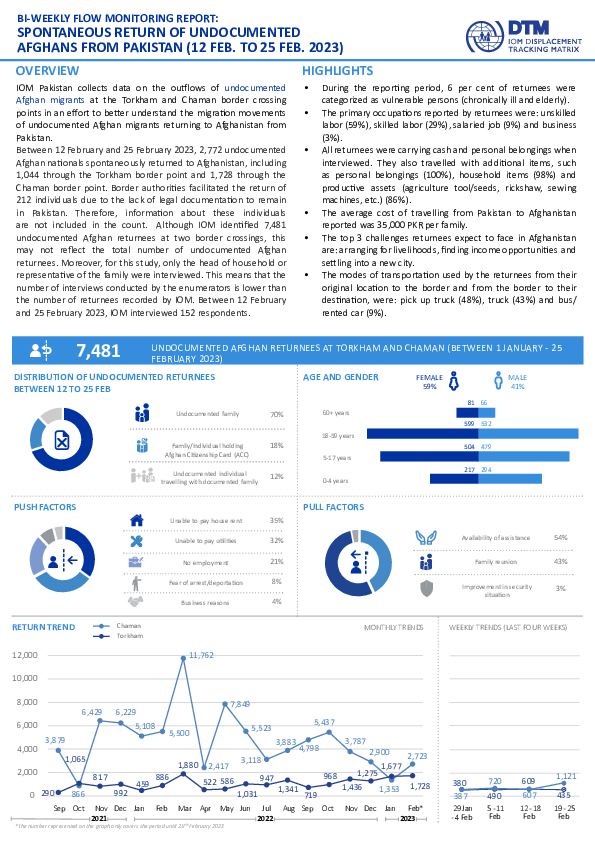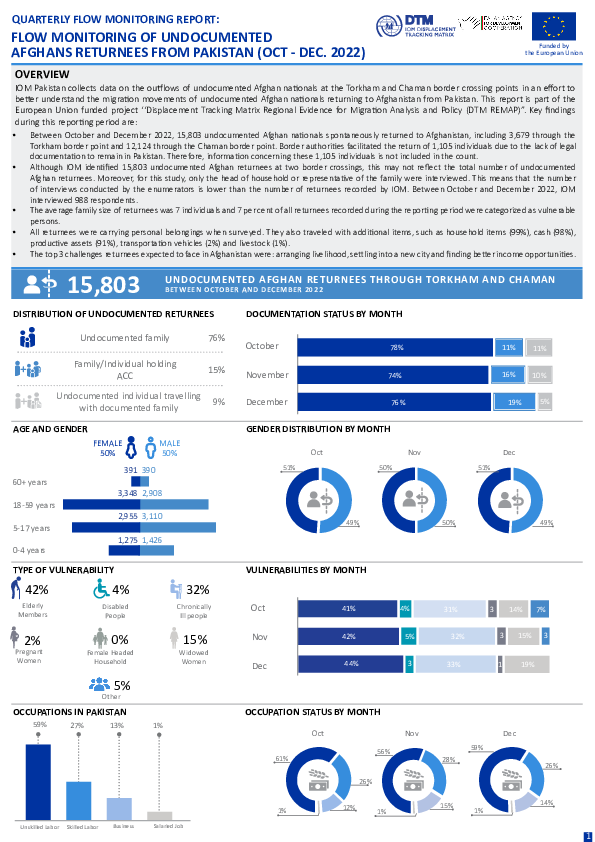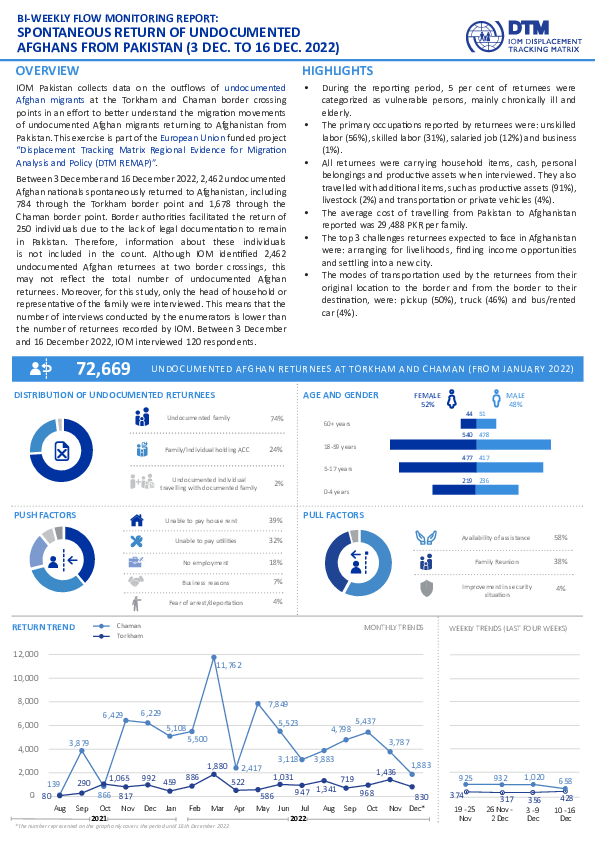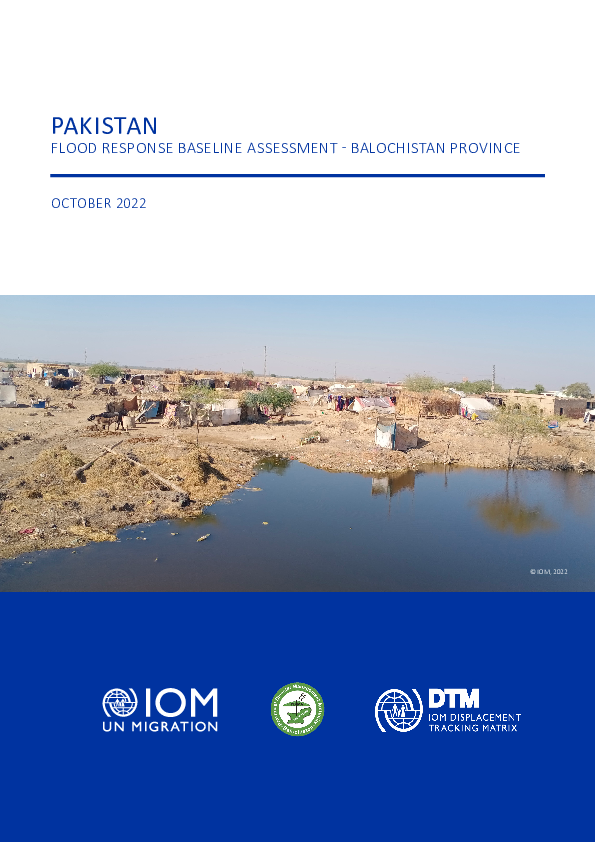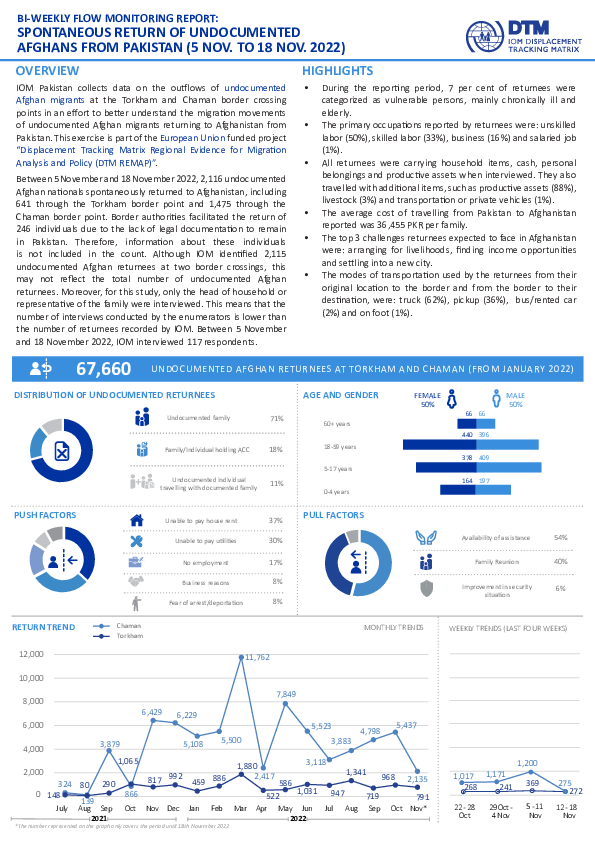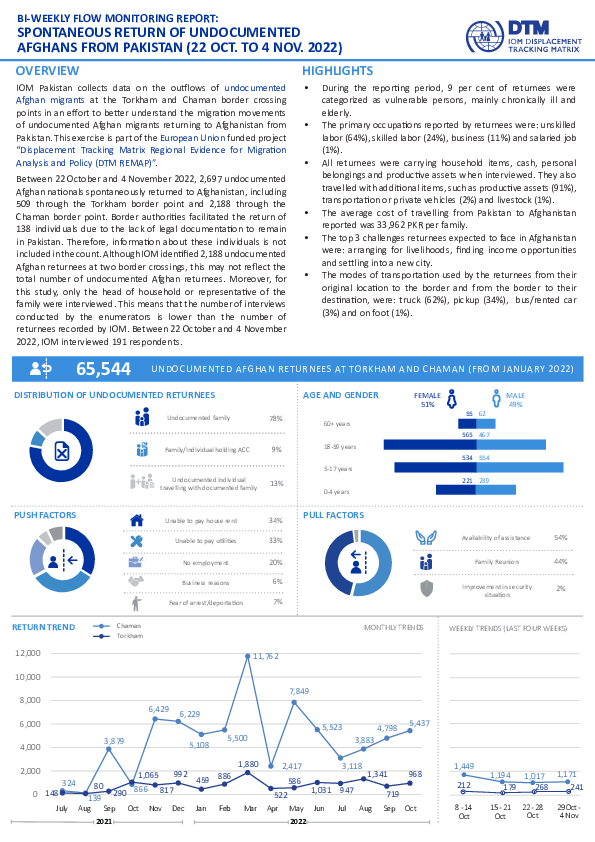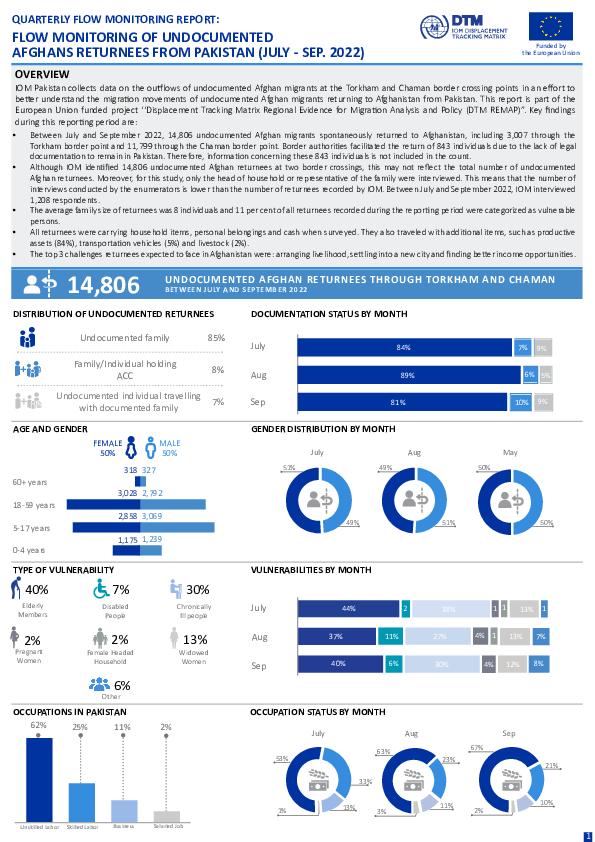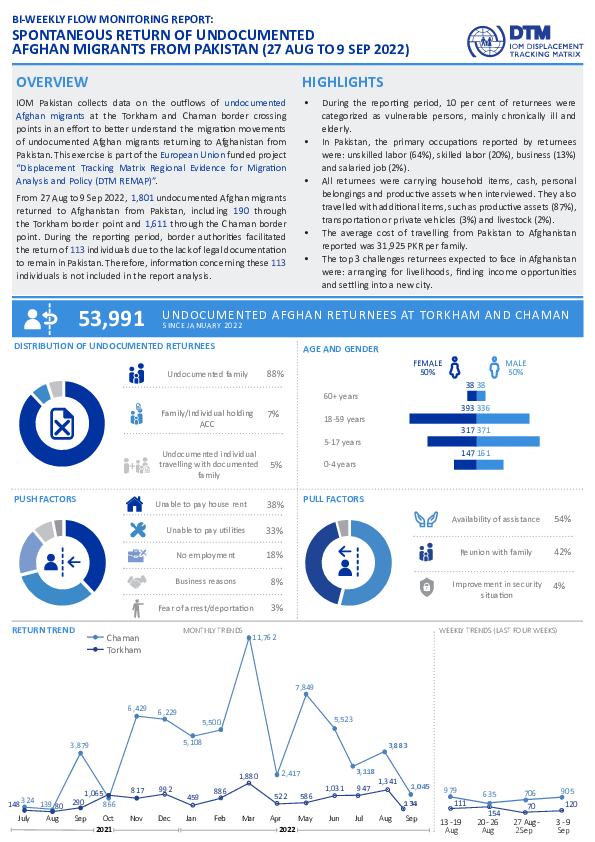-
Countries
-
Data and Analysis
-
Special Focus
-
Crisis Responses
Pakistan
Pakistan
TDPs tracked
Displacement Movements
23,000
IDMC 2023
Data collection round
About Pakistan
In 2010, IOM’s Displacement Tracking Matrix (DTM) programme started its activities in Pakistan as part of IOM’s emergency flood response programme. Over the years, DTM has evolved into a comprehensive programme covering a wide range of activities. The DTM programme works closely together with a wide array of stakeholders, including government ministries and national and sub-national statistical organizations, UN agencies, and specialized research institutes. Its activities are instrumental in providing stakeholders with an evidence-base to effectively address humanitarian, transition, and development needs within the country.
In 2017, DTM started the implementation of its Flow Monitoring (FM) activities. DTM collects FM data at the Torkham (Khyber Pakthunkhwa), Chaman, Badini and Bahramcha (Balochistan) border crossing points (BCPs) to identify cross-mobility patterns and profiles of Afghans who are returning from Pakistan to Afghanistan. The data presented in FM information products is harmonized with those from the United Nations High Commissioner for Refugees (UNHCR), who also cover Ghulam Khan (Khyber Pakhtunkhwa). DTM Pakistan also actively coordinates its data collection efforts with the DTM programme in Afghanistan.
As part of the 2022 flood response, DTM launched mobility tracking operations in flood-affected settlements or settlements that hosted temporary displaced persons (TDPs) across 11 districts in Balochistan and Sindh to provide partners with timely information on the displacement situation. Since then, DTM’s mobility tracking has expanded to cover 30 districts across three provinces (Balochistan, Sindh and Khyber Pakhtunkhwa) and collects information on the multisectoral needs and recovery needs at the settlement level, in addition to the displacement situation.
In May 2023, DTM scaled-up its mobility tracking efforts to support the ongoing response efforts for Afghans in Pakistan. DTM’s Afghan response has been implemented in 33 districts across Balochistan, Khyber Pakhtunkhwa, Islamabad, Punjab, and Sindh, and aims to provide stakeholders with up-to-date information on the multisectoral needs of Afghans in the country.
Furthermore, under the European funded project “Displacement Tracking Matrix Regional Evidence for Migration Analysis and Policy (DTM REMAP), from 2019 to 2022, DTM implemented two household surveys. The first survey was the survey on Drivers of Migration (SDM) which aimed at better understanding the drivers of Pakistani international out-migration. The second survey was the “Returnee Longitudinal Survey (RLS)”. The purpose of RLS was to improve understanding of return migrants’ profiles, vulnerabilities and needs, as well as sustainable return and reintegration outcomes in the short- and medium-term.
Contact
DTM Pakistan
DTMPakistan@iom.int
Current Donors
- EU-INTPA
- ECHO
- Ministry of Foreign Affairs of Italy
- PRM
- Canada – IRCC
- Canada (DFATD)
- Netherlands
Pakistan — Quarterly Flow Monitoring of Undocumented Afghan Returnees from Pakistan (January- March 2023)
IOM Pakistan collects data on the outflows of undocumented Afghan nationals at the Torkham and Chaman border crossing points in an effort to better understand the migration movements of undocumented Afghan nationals returning to Afghanistan from Pakistan.
Pakistan – Flood Response Community Needs Identification (CNI) Report Round 1 (Nov - Dec 2022)
Storms and heavy monsoon rains in Pakistan have caused widespread flooding and landslides across the country.
Pakistan - Flow Monitoring of Undocumented Afghan Returnees from Pakistan (15 - 28 January 2023)
Between 15 January and 28 January 2023, 1,416 undocumented Afghan nationals spontaneously returned to Afghanistan, including 805 through the Torkham border point and 611 through the Chaman border point.
Pakistan - Flow Monitoring of Undocumented Afghan Returnees from Pakistan (12 - 25 March 2023)
Between 12 March and 25 March 2023, 5,181 undocumented Afghan nationals spontaneously returned to Afghanistan, including 2,679 through the Torkham border point and 2,502 through the Chaman border point.
Pakistan - Flow Monitoring of Undocumented Afghan Returnees from Pakistan (26 February - 11 March)
Between 26 February and 11 March 2023, 6,264 undocumented Afghan nationals spontaneously returned to Afghanistan, including 3,132 through the Torkham border point and 3,132 through the Chaman border point.
Pakistan — Flow Monitoring of Undocumented Afghan Migrants: Summary Report 2022
This yearly summary report, in addition to bi-weekly and quarterly reports, aims to contribute to a better understanding of return movements of undocumented Afghan returnees by conducting more in-depth analysis on the data that was collected in 2022.
Pakistan - Flow Monitoring of Undocumented Afghan Returnees from Pakistan (12 - 25 February 2023)
IOM Pakistan collects data on the outflows of undocumented Afghan migrants at the Torkham and Chaman border crossing points in an effort to better understand the migration movements
Pakistan - Flow Monitoring of Undocumented Afghan Returnees from Pakistan (18 June - 01 July 2022)
IOM Pakistan collects data on the outflows of undocumented Afghan migrants at the Torkham and Chaman border crossing points in an effort to better understand the migration movements of undocumented Afghan migrants returning to Afghanistan from Pakistan.
Pakistan — Flow Monitoring of Undocumented Afghan Returnees from Pakistan (29 January - 11 February 2023)
IOM Pakistan collects data on the outflows of undocumented Afghan migrants at the Torkham and Chaman border crossing points in an effort to better understand the migration movements of undocumented Afghan migrants returning to Afghanistan from Pakistan.
Pakistan — Quarterly Flow Monitoring of Undocumented Afghan Returnees from Pakistan (October - December 2022)
IOM Pakistan collects data on the outflows of undocumented Afghan nationals at the Torkham and Chaman border crossing points in an effort to better understand the migration movements of undocumented Afghan nationals returning to Afghanistan from Pakistan.
Pakistan — Flow Monitoring of Undocumented Afghan Returnees from Pakistan (01 - 14 January 2023)
IOM Pakistan collects data on the outflows of undocumented Afghan migrants at the Torkham and Chaman border crossing points in an effort to better understand the migration movements of undocumented Afghan migrants returning to Afghanistan from Pakistan.
Pakistan — Flow Monitoring of Undocumented Afghan Returnees from Pakistan (17 - 31 December 2022)
IOM Pakistan collects data on the outflows of undocumented Afghan migrants at the Torkham and Chaman border crossing points in an effort to better understand the migration movements of undocumented Afghan migrants returning to Afghanistan from Pakistan.
Pakistan — Flow Monitoring of Undocumented Afghan Returnees from Pakistan (03 - 16 December 2022)
Between 3 December and 16 December 2022, 2,462 undocumented Afghan nationals spontaneously returned to Afghanistan, including 784 through the Torkham border point and 1,678 through the Chaman border point.
Pakistan — Flow Monitoring of Undocumented Afghan Returnees from Pakistan (19 November - 2 December 2022)
IOM Pakistan collects data on the outflows of undocumented Afghan migrants at the Torkham and Chaman border crossing points in an effort to better understand the migration movements of undocumented Afghan migrants returning to Afghanistan from Pakistan.
Pakistan – Pakistan Flood Response Baseline Assessment - Sindh Province (October 2022)
Storms and heavy monsoon rains in Pakistan have caused widespread flooding and landslides across the country.
Pakistan – Pakistan Flood Response Baseline Assessment - Balochistan Province (October 2022)
Storms and heavy monsoon rains in Pakistan have caused widespread flooding and landslides across the country.
Pakistan — Flow Monitoring of Undocumented Afghan Returnees from Pakistan (5 - 18 November 2022)
IOM Pakistan collects data on the outflows of undocumented Afghan migrants at the Torkham and Chaman border crossing points in an effort to better understand the migration movements of undocumented Afghan migrants returning to Afghanistan from Pakistan.
Pakistan — Flow Monitoring of Undocumented Afghan Returnees from Pakistan (22 October - 4 November 2022)
IOM Pakistan collects data on the outflows of undocumented Afghan migrants at the Torkham and Chaman border crossing points in an effort to better understand the migration movements of undocumented Afghan migrants returning to Afghanistan from Pakistan. This exercise is part of the Euro
Pakistan — Flow Monitoring of Undocumented Afghan Returnees from Pakistan (8 - 21 October 2022)
IOM Pakistan collects data on the outflows of undocumented Afghan migrants at the Torkham and Chaman border crossing points in an effort to better understand the migration movements of undocumented Afghan migrants returning to Afghanistan from Pakistan.
Pakistan — Quarterly Flow Monitoring of Undocumented Afghan Returnees from Pakistan (July - September 2022)
IOM Pakistan collects data on the outflows of undocumented Afghan migrants at the Torkham and Chaman border crossing points in an effort to better understand the migration movements of undocumented Afghan migrants returning to Afghanistan from Pakistan.
Pakistan — Flow Monitoring of Undocumented Afghan Returnees from Pakistan (24 September — 7 October 2022)
IOM Pakistan collects data on the outflows of undocumented Afghan migrants at the Torkham and Chaman border crossing points in an effort to better understand the migration movements of undocumented Afghan migrants returning to Afghanistan from
Pakistan — Flow Monitoring of Undocumented Afghan Returnees from Pakistan (10 — 23 September 2022)
IOM Pakistan collects data on the outflows of undocumented Afghan migrants at the Torkham and Chaman border crossing points in an effort to better understand the migration movements of undocumented Afghan migrants returning to Afghanistan from
Pakistan - Flow Monitoring of Undocumented Afghan Returnees from Pakistan (27 August — 09 September 2022)
IOM Pakistan collects data on the outflows of undocumented Afghan migrants at the Torkham and Chaman border crossing points in an effort to better understand the migration movements of undocumented Afghan migrants returning to Afghanistan from Pakistan.
Pakistan – Damage to Houses Due to Floods & Existing Population Density (as of 17 September 2022)
Severe monsoon weather since mid-June 2022 has affected up to 33 million people in the country. As of 6 September 2022, 81 districts have been officially declared as “calamity-hit” and 40 districts declared as “flood-affected”.
Sep 19 2022
Pakistan – Damage to Houses Due to Floods & Ex…



